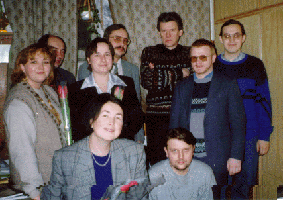

|
Never Destroy Anything
You Can’t Repair...
|
|

N. Tarasova with colleagues
|
Natalia Pavlovna Tarasova, Dr. Sci. in chemistry, professor, is
a head of Sustainable Development Department, Russian Mendeleev University
of Chemical Technologies, and associate member of Russian Academy of Sciences.
The department was formed quite recently, soon after 1992 Rio de Janeiro
UN Conference on Environment and Development had officially proclaimed
environmental problems to be the key to humanity survival in next millennium.
Since then, Natalia Pavlovna has been working on sustainable development
problems.
|
The world we live in is a fine-tuned system where everything is interrelated.
And ecological disasters resulting from human activities, however local
the might seem at first, inevitably trigger far-going environmental consequences.
And dissipation of ozone stratum is one of the gravest problems we face
today.
Q. Are ‘ozone holes’ actually this hazardous?
N.T. ‘Ozone stratum’ is a term we use to designate an
atmosphere layer with extremely high ozone concentration — dozens time
higher than in other air strata. Earth atmosphere is about 500 km thick,
and the ozone layer is 15 to 20 km above the surface. Alas, human interruption
in certain natural processes resulted in dissipation of the ozone layer,
and today humanity faces a terrible danger.
Ozone hole is an atmospheric area with ozone concentration reduced
by 10—15%. The hazard associated with ozone hole comes from high levels
of hard ultra-violet radiation coming through and reaching the surface
wherever the ozone layer has thinned. It badly affects human health and
is harmful to other species as well. The first surge of diseases associated
with exposure to hard ultra-violet was observed in 80s in Australia. Unlike
aborigines, white Australians could not properly adapt to relatively high
levels and fluctuation of radiation intensity; two centuries are not enough
for a population to adjust to new environments.
Ozone holes result even in harvested crops reduction! For example,
one per cent decrease of ozone concentration leads to 2% fall in output
of barley, corn, cucumber, beans, etc. The reason is that, once exposed
to ultraviolet rays, plants stop growing and begin synthesizing protective
chemical compounds to compensate negative effects of exposure. All these
plants had existed billion years before humans evolved. Actually, the had
existed before the ozone stratum formation completed. That is why they
successfully adjust to changing levels of ultraviolet radiation. And we
lack such instruments.
Ozone holes are dangerous to the extent that in 70s military laboratories
considered projects of ‘the most clean’ mass weapon which would kill by
destroying the ozone layer over target areas...
Q. What is the cause of ozone layer destruction?
N.T. There are two causes. The first is of chemical origin:
freon exhausts destroy atmospheric ozone. And the second is dynamic turbulence
of air. By the way, global climatic factors, such as hothouse gas, may
as well affect the ozone layer.
In 1987, the Montreal protocol was endorsed; participating countries
stated their commitment to keep freon production down from 1992 on and,
finally, give it up completely. More than 40 country endorsed the convention,
including most major nations (with the exception of China and India). The
USSR also signed it, and it was the first international agreement signed
both by the USA and the USSR after decades of the cold war. Before Montreal
we had never declared volumes of freon production.
The Montreal Protocol banned production and utilization of certain
substances of which there was scientific evidence that they destroy terrestrial
ozone stratum. Nations that had endorsed the protocol refused to manufacture,
buy, or sell products containing or manufactured with use of such substances.
And all the new synthetic substances pass examination to attest they are
harmless to ozone layer.
Q. Has the situation with ozone layer worsened since 1987?
N.T. Of course, it has! Freons have been produced since
1945. They were non-toxic, easily condensed and evaporated. So they seemed
an excellent substitute for highly toxic ammonia as freezing agents. People
were unaware of their dangerous ozone-destroying capacity. So today we
harvest the results of freon exhausts that happened back in 50s and 60s.
Even today many countries continue the malpractice of freon pollution.
Dr. Dennis Meadows of New Hampshire University believes that we have already
reached the level of atmosphere freons enough to destroy 60 to 70% of ozone!
If so, the global catastrophe is inevitable. Probably, the Nature has some
powers to regenerate the ozone layer, as for us, we only have to guess...
Q. Maybe, freons can be substituted with something else, just
like they substituted ammonia?
N.T. Though resources are scarce, researchers do their
best to develop freon substitutes with life-time about ten times shorter.
Such substitutes will disintegrate before they reach the ozone layer which
greatly reduces the ozone-hole risk.
Q. And what are the mechanics of ozone destruction by freons?
N.T. Once freon molecules reach the ozone stratum, ultraviolet
rays disintegrate them into free radicals which enter into chain reaction
with ozone molecules. A single freon particle has a potential to break
up to ten thousand ozone molecules into regular and atomic oxygen.
Besides freons, other ozone-destroying agents exist. For example nitrogen
oxides. One of them, dinitrogen oxide (‘laughing gas’) is produced by bacterial
participants of nitrogen circulation. This agent is characterized by extremely
long life-time, and the more nitric fertilizers we use, the more dinitrogen
oxide output is. Besides ozone demolition, it does a lot to worsen the
hothouse effect on planetary scale.
Generalizing, sources of nitrogen oxides are copious: power plants,
oil and gas burning transport, and so on. Nitrogen oxides concentration
in terrestrial atmosphere consistently grows. Though life-time of most
nitrogen oxides is relatively short and they cannot affect the ozone layer,
their input in hothouse effect is significant. Ironically, mankind has
found and actively exploits ways of direct transportation of nitrogen oxides
to the ozone stratum: that is, space rockets and jet planes.
Q. And how does the hothouse effect impair the ozone layer?
N.T. The hothouse effect results in climatic changes
and affects atmospheric dynamics. Some scientists believe that these changes
might have caused ozone holes over Central Siberia which periodically span
as far in southern direction as to endanger Krasnoyarsk.
Q. Can we do something to restore atmospheric ozone concentration?
N.T. Some ideas of how we could ‘mend ozone holes’ exist.
However, the only actual formula is the same as ever: Never destroy anything
you can’t repair. We cannot restore natural environments; only the Nature
can, and it will take time and lack of human intervention.
| Q. Are you a member of some ecological organization?
N.T. No, I’m not. But we cooperate a lot. We teach ecologists
to deal with executives of industrial companies potentially responsible
for environment pollution, perform analysis of associated risks, plan public
campaigns, make people at high places take them into account, use legislative
and regulatory levers, and so on. Currently, we plan our participation
in an educational program of Siberian Agreement Association which is to
acquaint Siberian public with basics of sustainable development concept.In
general, I must admit that ecological organizations are made of good people
with good intentions.
|
 |
Non-formal organizations and citizens must have access to information
about environments the live in, must have an opportunity to ask legislators
they have elected what they are doing to protect them. Then governments
of all levels will have to react. But to ask right questions in right places,
a person must have some basic information about the matter. When only a
few persons understand what environmental problems exist in their region,
the situation is actually terrible! Uneducated people are so easily manipulated,
because they lack power of judgement, they lack opinion of their own! It
takes a little persuasion to make them believe in any lie and go out demonstrating
for or against whatever you want!
And the more educated they are, the more weighed and thoughtful are
their actions, the higher is the level of their responsibility for what
goes on around them. That is why comprehensive education is so important,
and in this country it must be very specific sort of education to make
people proud of their nation and confident in their government.
In Japan, for example, they plan university education for all; in America,
education undergoes fundamental changes... An opportunity to receive university
education must exist for individuals of any age — even after 60 — and social
status. It might be evening classes or by-correspondence educational programs.
It was G.A. Yagodin, the last Minister of Education in the former USSR,
who first articulated the idea. Today we witness to its resurrection. Unfortunately,
education suffers of financial shortages which come from utter ignorance
of its importance. Within few years we may lose everything we still have:
talented students, academicians, research centers... And we shall be forced
to exist on margins of human civilization.
Q. I don’t think we are ready to introduce ‘university education
for all’ yet. Even technical schools are visualized as burdensome by many.
Probably, the entire educational system need be restructured...
N.T. You are right. But there is too much inertia in
educators themselves. For instance, our department has spent many efforts
adapting best international textbooks in natural sciences, so they could
be introduced in regular schools. And the problem we faced was that many
schoolteachers were simply scared by these textbooks, because every specific
topic of chemistry, for example, was explained there in a manner absolutely
unusual for them, that is incorporated elements related to other fields
of human knowledge: geography, physics, medicine, etc.
Recently we have designed a new education course, ‘Problems of Sustainable
Development’, which covers global problems and is based on the concept
that our planet develops as the integrated system. Back in 1972, Dennis
Meadows and colleagues applied J. Forester’s methods of system dynamics
to global evolution and produced the model of the future that shocked the
world. Though Russian public was shocked twenty years later (after Russian
translation was published). The model took into account all basic measures
describing human race and its activities: population, quality of living
environments, resource utilization, industrial and agricultural product
per capita, etc. Dr. Meadows and colleagues demonstrated that if current
rates of utilization and production persist, by the middle of 21st century
humanity will face a global crisis of such intensity that one half of its
population will be wiped off the face of the planet.
First, humanity will suffer from dramatic shortages of natural resources
— and that is what we already experience. Lack of natural resources will
lead to global energy crisis which, in turn, will result in dramatic fall
of industrial and agricultural production. All the above will be accompanied
by uncontrollable growth of the population in the third world and extreme
global pollution. Here is the scenario of inevitable global collapse.
That is why — to keep our planet alive and intact — we need work on
these problems here and now! Humanity must react to them in preventive
manner. Many countries have already developed and approved national concepts
of sustainable development based on principles of pollution control, stable
population, improved standards of living, including better education, culture,
etc. And we must step on the same path until it is too late.
Interview by Elena Chernomazova

![]()


